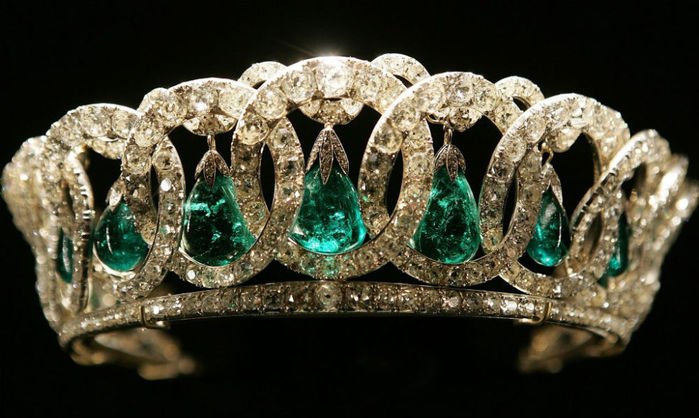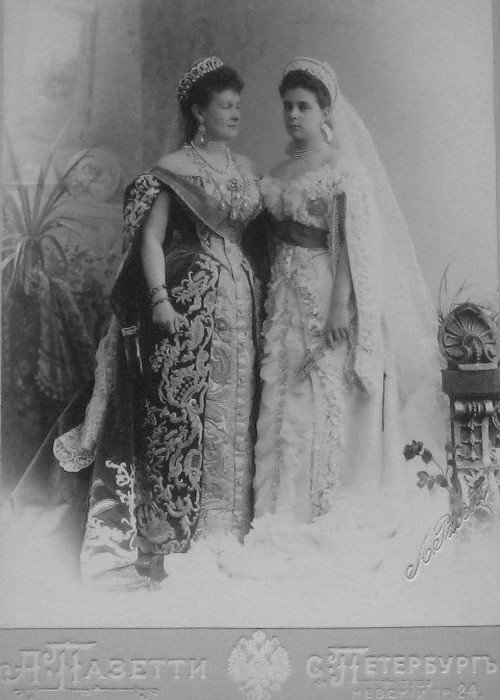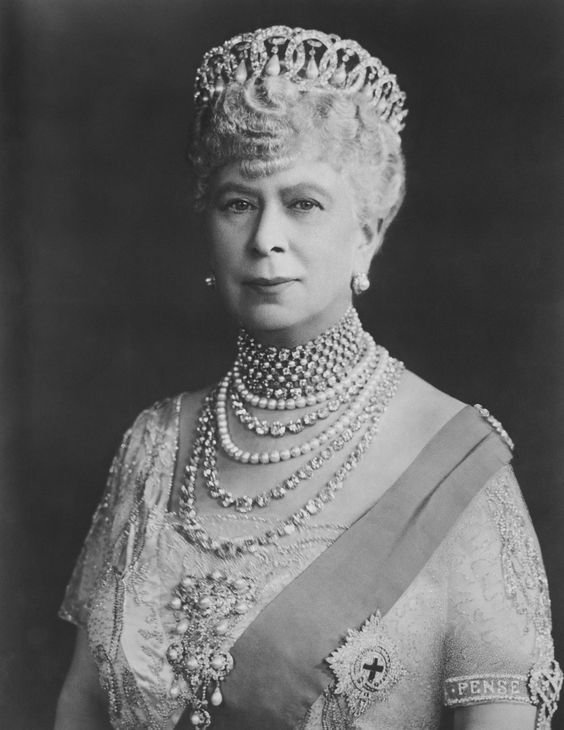THE GRAND DUCHESS VLADIMIR TIARA
The Grand Duchess Vladimir tiara owned by Queen Elizabeth II, which she inherited from her grandmother Queen Mary. It is shown hung with the Cambridge emeralds, which she also inherited from her grandmother.
This beautiful piece of jewellery has graced the heads of three magnificent matriarchs of royal dynasties: the Grand Duchess Vladimir (who commissioned it), Queen Mary (who bought it) and Queen Elizabeth II (who inherited it), and is associated with a romantic story of escape during the Russian Revolution.
It was ordered in the 1870s from Bolin, Russia’s most famous jeweller after Fabergé, around the time of Marie’s marriage into the Romanov family. It must have been one of the first of many important pieces of jewellery to come her way. Its style was a revolution in simplicity by the standards of the time when the leading trend was the Garland style, with jewellery tending to be modelled on elaborate festoons of flowers.
The Grand Duchess Vladimir began life as Princess Marie of Mecklenburg-Schwerin, a scion of a relatively modest principality in Germany. In spite of considerable opposition she married the Grand Duke Vladimir, uncle of Tsar Nicholas II and into a life of unimaginable splendour. A weaker character would have been overawed by this newfound status, but Marie revelled and excelled in her position. Stories abound of her hosting fancy dress parties where she wore jewel encrusted peasant style dresses. The Tsarina Alexandra was steadily withdrawing from public life due to her son’s haemophilia (which was then a State secret), so Marie developed a glittering rival court in St. Petersburg. She cultivated her jewellery collection to enhance this position, from whence she patronised the foremost artists and revolutionary styles of her day. The Grand Duchess included in her collection wonderful stones then considered slightly inferior such as cat’s eyes and tourmalines.
The Grand Duchess Vladimir wearing the tiara she commissioned from Bolin. She is photographed with her only daughter, Elena, who married Prince Nicholas of Greece. She sold the tiara to Queen Mary in 1921. Her daughter Marina married the Queen's uncle, the Duke of Kent. Note the grandeur and sumptuousness of their Court dress.
The circle tiara was hugely successful and its groundbreaking style was recognised by Cartier, who took the opportunity to make three copies of it when it was sent there for cleaning. It was clearly a favourite, as there are several existing official photographs of the Grand Duchess wearing the piece throughout her life.
The Grand Duchess finally escaped Russia in 1919, taking with her only a small bag of her once vast treasure. The bulk of her possessions were left walled up in her St. Petersburg palace, when a relatively junior figure at the British Embassy called Bertie Stopford took it upon himself to break into the yet undiscovered safe and smuggle the treasures out of Russia on behalf of the Romanov family. There is a romantic, though unsubstantiated story that Stopford stuffed the tiara into a black bonnet whilst disguised as an old woman, and the pearls were concealed into false cherries sewn onto this. The majority of the jewels were re-united with their owner, who died in exile in 1920 at Contrexéville in France. The jewels were divided by her children according to stones, the diamonds going to the Grand Duchess Elena (who married Prince Nicholas of Greece), the pearls to Grand Duke Cyril, the emeralds to Grand Duke Boris and the rubies to Grand Duke Andrei. The tiara was bought from Princess Nicholas of Greece in 1921 by Queen Mary, whose daughter Marina married the future Duke of Kent.
Queen Mary also altered the tiara to make the pearl drops interchangeable with emerald cabochon drops, and the Queen has been photographed many times wearing it with either stone. At a State Banquet in Latvia in 2006 the piece was worn with no drops.
The Queen wearing the Grand Duchess Vladimir tiara with the rest of the Cambridge emeralds. The necklace is also hung with a cleaving from the Cullinan diamond.
The Vladimir tiara hung with its original pearls. It was completely reset in the late 1990s by Garrards onto a more resistant platinum frame.
Queen Mary wearing the Vladimir tiara. Note her diamond studded Garter star.





